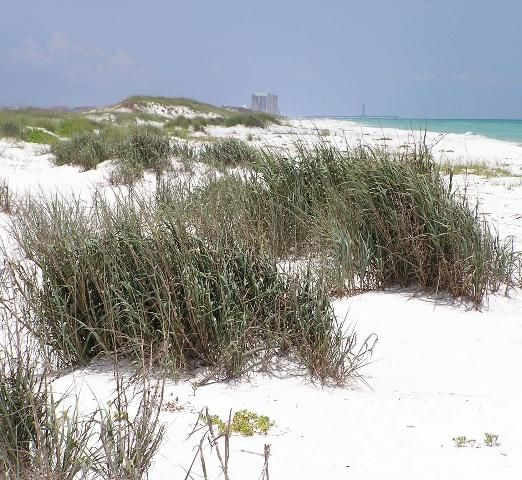Note: This fact sheet is also available as a chapter in a comprehensive manual titled Dune Restoration and Enhancement for the Florida Panhandle, available in pdf form here: https://edis.ifas.ufl.edu/publication/SG156. Please see the manual for more information about other useful and attractive native plants for dunes and for further information about restoration and preservation techniques.
Poaceae

Credit: Josiah Raymer, UF/IFAS
Bitter panicgrass is important in dune stabilization and building and often grows intermixed with sea oats on foredunes. It is also found spread throughout back dunes, interdunal swales, and coastal grasslands. This plant occurs throughout coastal Florida, except for the Big Bend coast, west to New Mexico, and along coastal northeast states to Massachusetts. A significant proportion of bitter panicgrass reproduction is by vegetative spread; its seeds are often sterile.
General Description
Bitter panicgrass is a bluish green, rhizomatous, perennial, clumping grass that can reach heights of 3.3 ft or more. Aboveground stems (culms) are thick, branch from lower nodes, can be upright or horizontal, and have glabrous (smooth) nodes and grey glabrous to glaucous (waxy) internodes. Leaves are up to 20 in long and 0.75 in wide, and have flat bases and smooth and involuted tips. The sheaths are glabrous with hairy upper margins. The ligules are membranous, up to 0.33 in long, and ciliate. Inflorescences are elongated panicles, up to 20 in long. They occur in late spring to late summer. Panicles are narrow, slightly nodding, and densely flowered. Flowers are typical grass spikelets, somewhat purple/gray, 0.33 in long, glabrous, and ovoid with lower glumes that reach half the spikelet length and are 3- to 9-veined. Fruits are smooth, shiny achenes and are also purple/gray.
Propagation
Above- and below-ground portions of bitter panicgrass can produce new plants (Willis and Hester 2008). Culms with at least 2 nodes can be placed vertically in a pot with well-draining propagation medium (USDA NRCS 2017). Seedlings from a wild Louisiana population were successfully transplanted to a greenhouse and grown in 2L (0.53 g) pots with 1.6-mm sieved and sterilized sand collected at the growing site (Hester and Mendelssohn 1990). These same plants did not respond to micronutrient application but did respond positively to macronutrient fertilizer application one week after transplanting. Additionally, humic acid (80g/mL) has been used to increase biomass for container-grown bitter panicgrass (Willis and Hester 2008).
The authors collected elongated culms and dissected them into single-node cuttings. These cuttings were placed in a coarse propagation substrate containing milled pine bark. The cuttings were inserted vertically to a depth that placed the visible bud at the node even with the substrate surface. Cuttings placed under intermittent mist produce roots within a few days. Once roots are evident, the rooted cuttings should be placed on greenhouse benches to grow until new shoots are a few inches tall. Well-rooted liners can be transplanted to 4-in pots and outplanted within 4 to 6 weeks when rootballs are sufficiently dense to hold the substrate together when the plant is removed from the pot. Timing will depend on root growth rates.
The potential for collection of nonviable seed is high and likely to be an important factor in producing these plants from seed. Seed viability varies considerably across populations and year collected (Senaca 1969).
Outplanting
Miller et al. (2001) reported increased growth (more tillers and more branching) for bitter panicgrass when it was planted in March than when it was planted in December. Bitter panicgrass can be transplanted during the summer, but summer planting is not recommended unless supplemental water is available or rainfall is consistent (i.e., rainfall levels are average or above average). Planting without supplemental water in May, the lowest rainfall month is not recommended unless supplemental water is available or rainfall is consistent.
Literature Cited
Hester, M.W., and I.A. Mendelssohn. 1990. "Effects of macronutrient and micronutrient additions on photosynthesis, growth parameters, and leaf nutrient concentrations of Uniola paniculata and Panicum amarum." Botanical Gazette 151(1):21–29.
Lamphere, J. 2017. "Plant guide – bitter panicum." USDA NRCS Golden Meadow Plant Materials Center. United States Department of Agriculture (USDA) Natural Resource Conservation Service (NRCS). The PLANTS Database. http://plants.usda.gov/plantguide/pdf/pg_paam2.pdf
Seneca, E.D. 1969. "Germination response to temperature and salinity of four dune grasses from the outer banks of North Carolina." Ecology 50(1):45–53.
Willis, J.M., and M.W. Hester. 2008. "Evaluation of enhanced Panicum amarum establishment through fragment plantings and humic acid treatment." Journal of Coastal Research 24(2B):263–268.
Miller, D.L., M. Thetford, and L. Yager. 2001. "Evaluation of sand fence and vegetation for dune building following overwash by Hurricane Opal on Santa Rosa Island, Florida." Journal of Coastal Research 17(4):936–948.